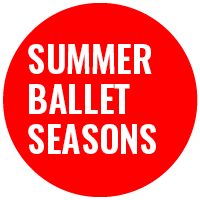SUMMER BALLET SEASONS
The repertoire of the Summer Ballet Seasons includes more than twenty ballets, from the pure classics of Tchaikovsky to the avant-garde of Prokofiev, from the romanticism of Adan to the brilliance of Minkus. The participants are the best troupes of Russia, guest soloists of the Bolshoi, the Kremlin ballet, MAMT im. Stanislavsky and other leading theaters of the country.
For 22 years, the performances of the Summer Ballet Seasons have been visited by more than a million people! From a project for foreign tourists, Seasons has grown into a wide parade of classics for all art lovers, whose mission is to preserve the rich traditions of Russian ballet, one of the most important and brightest parts of the cultural heritage of Russia, and to introduce art to the widest audience.
Summer Ballet Seasons are a great opportunity to get acquainted with the classics at any age (there are always evening and daytime performances for children on the playbill), compare different editions and readings of famous ballets by the best dance groups in the country, enjoy the perfect fairy tale, live orchestra playing, luxurious scenery and rich costumes within the walls of the old Imperial Theater a stone's throw from the Bolshoi.
Today, the Seasons is a good tradition of the cultural life of summer Moscow, not only a theatrical, but also an educational event, the organizers of which are in constant search for new professional groups and bright productions that preserve the continuity of generations in the art of ballet dance.
The cost of tickets for performances varies from 500 to 5000 rubles, which makes the event accessible to a large number of spectators.
We are now bigger than summer!
The summer marathon of classics began in 2001 and has not ended to this day.
When we are so accustomed to summer ballets that we cannot part with you and present several performances in the fall.
Our traditional New Year's fairy tale in December and January.
We missed you a lot! We present several ballets in winter and spring before the start of the Seasons.
In 1840 the house was bought by the merchant P.A. Bronnikov. Between 1869 and 1882 the merchant rented the second floor to the theater of Moscow's "Artistic circle". This group of prominent literary men and artists was established by playwright Alexander Ostrovsky. The "Artistic Circle" theater was one of Russia's first private theaters.
In 1882 the building was rented out by the famous actor, director and entrepreneur M.V. Leontovsky. He hired architect B.Freidenberg to reconstruct the house, changing it significantly. The building has been preserved pretty much unchanged to this day. Leontovsky, who was a student of M.S. Tschepkin, strove to create an exemplary drama theater with a diverse repertoire that would combine operetta, extravaganza and the art of drama. Such theater was opened on December 29, 1882, but it did not last long.
In September 1898 the building became a home to the Imperial New Theater, which lent its stage to the youth troupes of Bolshoi and Malyi theaters. The young actors' troupe of the Malyi Theater was headed by the actor, director and pedagogue A.N. Lensky.
In the beginning of the 20th century the stage housed performances by the private opera of S.I. Zimin. In 1909 the building was rented out by a well-known entrepreneur, director and actor K.N. Nezlobin.
In 1920s the opera and ballet performances of Bolshoi Theater took place in this building. In the fall of 1924 the First Studio of the Art Theater was given the name of MKhAT (Moscow Art Academic Theater). The new theater was given the building on Theater Square. It lasted until 1936.
Starting in 1936 the building houses the Central Children's Theater that was established in 1921 by Natalia Satz. It has started the professional careers of Anatoly Efros, Georgy Tovstonogov, Oleg Efremov, Viktor Rozov, Valentina Sperantova and many others.
In 1992 the theater was given a new name – Russian Academic Youth Theater.
The idea to organize SUMMER BALLET SEASONS belongs to the CONSARTA agency, which for many years has been organizing the tours of various theaters, orchestras, choral and folklore groups as well as exhibitions both in Russia and abroad – in Great Britain, Belgium, Italy, Spain, Poland, Australia, Hong Kong, China, Korea, Singapore, Turkey, Cyprus and Baltic states.

In 2010 the agency organized the International Children's Forum in the French town of Avignon, and in 2011 it was one of the co-organizers of the International Children's Forums in Spain and Italy.
CONSARTA has established relations with a number of Russian capital's social organizations: orphanage pupils, children from low-income families, handicapped persons and WWII veterans attend the performances of Summer Ballet Seasons on preferential terms.
The head of Summer Ballet Seasons is a permanent member of the International Society for the Performing Arts (ISPA) and teaches a special course on "Guest tour organization" at the "Cultural entrepreneurship" department of the International University in Moscow. In 2007 Alla Nemodruk was awarded Order of Dyagilev "For benefitting the Russian culture".
In 1730s the French ballet dancer Marie de Camargo shortened the skirt and decided against wearing heels. This allowed her to introduce a new ballet move – striking one foot against the other in the air.




Dyagilev's Seasons not only had a great influence on the development of Russian ballet, but also made everything Russian very fashionable. For example, English dancers Patrick Heely-Key, Alice Marx and Hilda Mannings took Russian pseudonyms Anton Dolin, Alicia Markova and Lydia Sokolova respectively. The wife of the British king George VI was married wearing a "dress that paraphrased Russian folklore traditions".

More than two centuries later Ballet Seasons are back to conquer the audience!
The Seasons' idea — to preserve Russia's cultural heritage — became the foundation of the program, which consists of the best classical ballets performed by well-known Moscow troupes. The performances reconstruct the staging by legendary choreographers — Marius Petipa, Vasily Vyonen, Asaf Messerer and others. It was thanks to these stage plays that the Russian ballet earned its fame as the world's most masterful and professional. The pearls of classical ballet are presented on one stage for two summer months and are accessible to any fan and connosier of the classical ballet.

